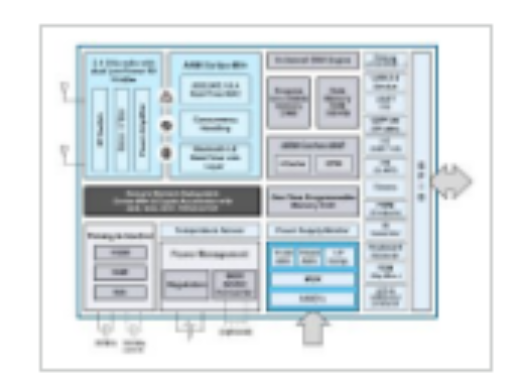Qorvo has announced a system-on-chip for smart home devices with multi-network support for Matter, Zigbee and Bluetooth Low Energy.
“QPG6200L supports multiple protocols on separate channels simultaneously for consumer IoT applications including smart lighting, sensors and home hubs. It also leverages a built-in secure element and is PSA Certified Level 2 for enhanced IoT security,” according to the company, whihc claims that it “enables the adoption of Matter while supporting existing Zigbee networks without trade-offs in latency and link performance”.
Up to 3 IEEE 802.15.4 networks can operate on different channels – Zigbee and Matter, for example – and multiple radios allow continuous scanning for incoming packets across Bluetooth Low Energy and IEEE 802.15.4 protocols. Antenna diversity is included for Bluetooth Low Energy and IEEE 802.15.4.
The radio is compliant with ETSI EN 300 328 and FCC CFR-47 Part 15, transmitting up to +10dBm, adjustable down in 1dB steps
The IEEE 802.15.4-2020 radio for Matter, Thread and Zigbee operates at up to 250kBit/s and can receive -102dBm at maximum sensitivity.
For Bluetooth, it is v5.4 compliant including Bluetooth Mesh v1.0. Data rates are 2Mbit/s (-94.5dBm sensitivity), 1Mbit/s (-97.5dBm), 500kbit/s or 125kbit/s (-105dBm).
Antenna diversity gain is 8dB – this and all the other figures come with caveats – see the preliminary data brief for more.
Processing is by a 192MHz Cortex-M4F (with DSP), 2Mbyte of flash and 336kbyte of ram.
Packaging is 4 x 4mm 32pad QFN.
The associated development kit, QPG6200LDK-01, has a QPG6200 radio board with printed antennas and certified communication stacks.
The radio board plugs into an included carrier board which has an integrated Segger J-Link debugger-programmer and virtual COM port via USB-C.
Alongside a 16 Mbit SPI flash on the carrier are peripherals for IoT applications including an RGB, cool white and warm white LED, an I2C humidity and temperature sensor, an I2C accelerometer, five push buttons and a slider switch.
Additional sensors and peripherals can be connected via an Expansion is via an Arduino (Uno Rev3) Shield compatible socket.
QPG6200L web page from which preliminary data sheet can be downloaded
QPG6200L development kit web page
Original article source:
Smart home IC speaks Matter, Zigbee and Bluetooth Low Energy
FAQ
1.What is a Smart Home IC?
A smart home integrated circuit (IC) is a specialized chip designed to manage and control various smart home devices. It integrates multiple communication protocols like Matter, Zigbee, and Bluetooth Low Energy (BLE) to enable seamless connectivity between devices such as smart lights, thermostats, and security systems.
2.What is the Matter protocol, and how does it work with Smart Home ICs?
Matter is an open-source connectivity standard designed to unify smart home ecosystems. Smart Home ICs with Matter compatibility can connect and communicate with a broad range of devices from different manufacturers, simplifying interoperability and reducing the fragmentation of smart home products.
3.How does Zigbee work in smart home devices?
Zigbee is a low-power, low-data-rate wireless communication protocol that forms mesh networks, enabling devices to communicate over longer distances by relaying signals through other Zigbee devices. Smart Home ICs that support Zigbee allow devices to connect in a stable and energy-efficient manner.
4.What is Bluetooth Low Energy (BLE), and why is it important for smart homes?
Bluetooth Low Energy is a wireless communication protocol that provides energy-efficient, short-range communication. BLE is crucial for devices that need to be battery-efficient, such as smart locks and wearable devices. Smart Home ICs with BLE enable these devices to communicate quickly and with minimal power consumption.
5.Can a Smart Home IC support Matter, Zigbee, and BLE simultaneously?
Yes, many advanced Smart Home ICs are designed to support multiple communication protocols like Matter, Zigbee, and BLE. This allows the same chip to handle different types of smart home devices, improving compatibility and simplifying the design process for manufacturers.
6.Why are multi-protocol Smart Home ICs beneficial for consumers?
Multi-protocol Smart Home ICs provide consumers with more flexibility in setting up and expanding their smart home ecosystems. Devices with Matter, Zigbee, and BLE can communicate with each other, regardless of the specific protocol they use, ensuring a more seamless and integrated smart home experience.
7.Are Smart Home ICs future-proof?
Many Smart Home ICs are designed with future-proofing in mind, meaning they can support updates to protocols like Matter, Zigbee, and BLE. This ensures that devices can remain compatible with new smart home products and technologies as they evolve, protecting consumers’ investments in their smart home setups.
